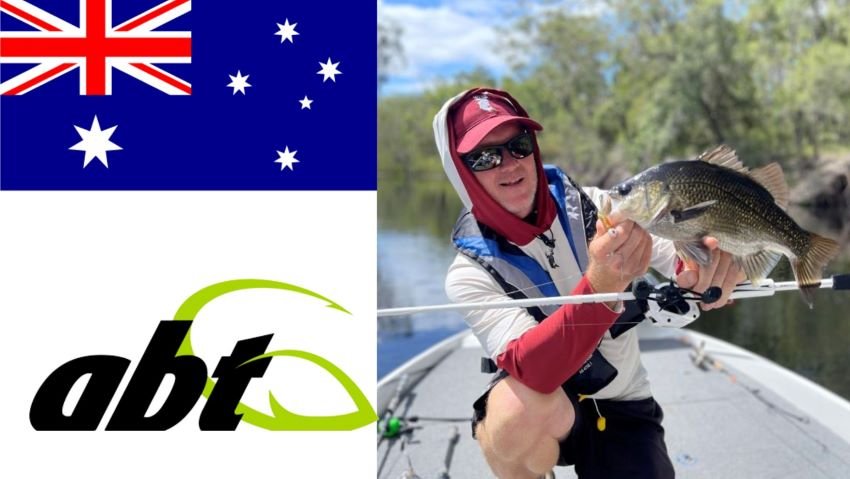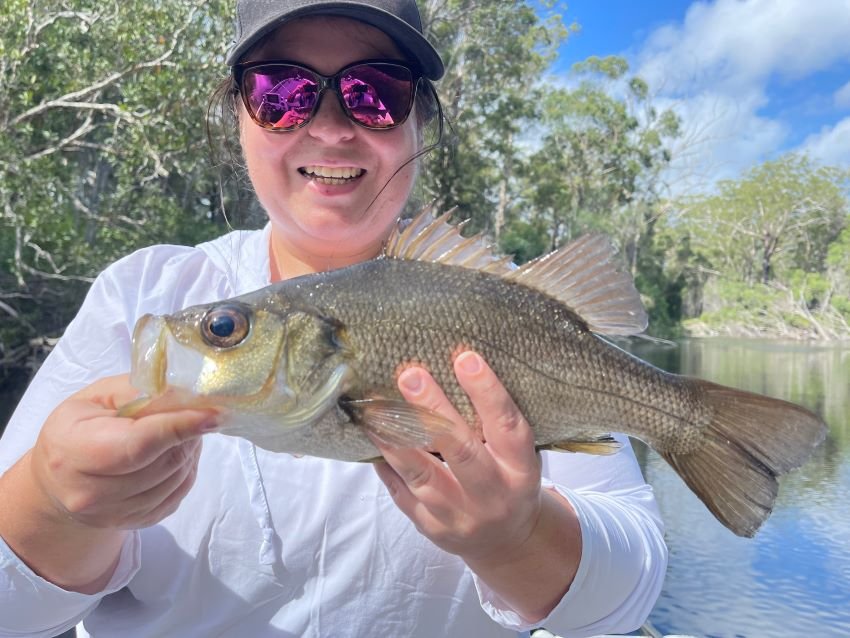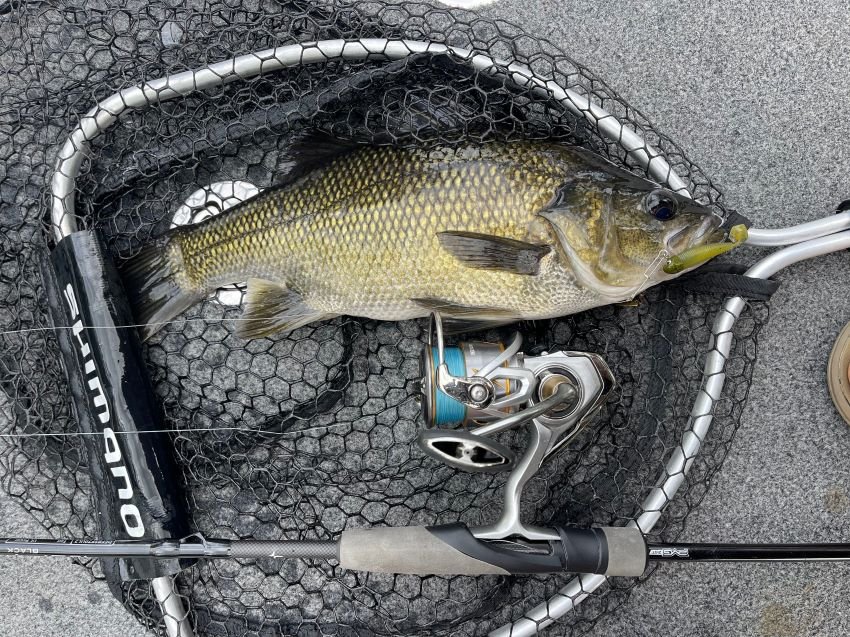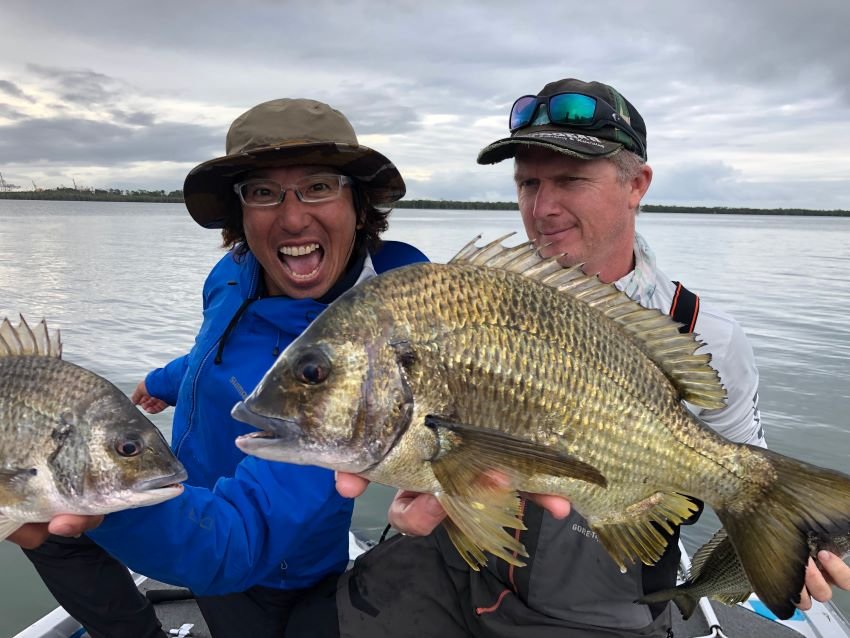Australian Bass Tournament Basics from Steve Morgan
One of the highlights of my 2023 Bassmaster Classic experience was the opportunity to meet, interview and film the Australian fans who came to cheer for Carl Jocumsen – and, by extension, for Jocumsen proxies like eventual champ Jeff Gustafson.
The Aussies were rightfully recognized as one of the brightest lights in an otherwise already-fantastic event. Their energy, enthusiasm and volume brought an extra dose of life to Knoxville. One of their ringleaders was Steve Morgan, the Director of the Australian Bass Tournaments and one of Carl’s long-term supporters. I remained in touch after we both returned home, and wondered about the nature of their fisheries and their derbies. Steve was kind enough to quickly and thoroughly answer my first round of questions:
How do your bass differ from what Americans call bass?
Apart from the name and that there’s some similar baits that they eat, Australian bass (Macquaria maculeata) and North American bass aren’t closely related.
In their natural environment, they travel down from the freshwater stretches of accessible rivers down to the brackish water, where they need salinity of about 13 ppt (around 1/3 of full seawater) for the eggs to survive after schooling fertilisation.
This spawn happens in the cooler winter months on the east coast from around Bundaberg in Queensland through to eastern Victoria. Australian bass are only an east coast species whose range is east of the Great Dividing Range. So they’re only in a small part of the country.
They share a small bit of range with the iconic Murray cod (that inhabits western flowing rivers) and spawns in the fresh) and the barramundi, which has a very similar life cycle, but in the northern (warmer) rivers.
If the river is blocked by a weir or dam, that limits the upstream range of the Australian bass, which means that every single fish that’s in any of our impoundments has been grown in a hatchery and stocked.
There are several stocked Australian bass impoundments in Victoria, New South Wales and Queensland and the fish are available in basically every eastern flowing, unblocked river throughout their range.
SO our bass don’t make a bed in spring or have really any seasonal changes in behaviour as much as North American bass. A lot of the time they roam, suspended around impoundments or relate to structure in these habitats.
Are there different strains – similar to our largemouths/smallmouths/spots? If so, what are they, and how are they different from one another?
There’s likely a few different ‘strains’ of Australian bass, but none of these are a different species or look any different to anyone, unless you’re a geneticist.
If I was to describe an Australian bass, they look a little like a white bass and hit and fight like a smallmouth, but without the jumps.
There is a closely related species that’s saltwater-only called the Estuary Perch. These are a little taller and thinner than a bass, but half the anglers can’t even tell the difference. We let anglers weigh both in tournaments.
What are some of the most famous or popular fisheries?
Some of the famous river bass fisheries include the Noosa River in Queensland, where the fish grow slowly in slow, tannin stained waters.
The Clarence River in northern NSW has likely the largest population of river bass. There’s a natural gorge half way up the river where the migrating fish can get bottlenecked and it isn’t every year that the fish can get back upstream.
Sydney’s Hawkesbury River has bass - mainly upstream and a healthy population of EPs downstream.
South of Sydney, the Shoalhaven River is a picturesque and productive river fishery.
Famous lakes include Brisbane’s Somerset and Wivenhoe, that yield world-record sized fish up to 4.5kg and limits of up to 25lb for 5 fish.
The Hunter Valley’s Glenbawn Dam and Lake St Clair are the most popular NSW impoundments and are about 3 hours drive north of Sydney. Fish here average around 2 pounds apiece.
New on the ABT circuit are Victoria’s Blue Rock and Glenmaggie dams, where the bass grow slower, but are mixed with trout and European perch. A 2 pound fish here is a kicker.
How long has ABT been around?
ABT was founded in 1999 in Brisbane, Australia as a private company linked to Fishing Monthly Magazines (which has common ownership).
We run events for bass, but also for barramundi and saltwater bream (like a sheepshead).
Gussy and Carl fished 4 barramundi events last year. It seems like it was a good off-season tactic!
How do your tournaments compare to what bass anglers in the US compete in – typical 8 hour, five fish limit?
The tournament formats are nearly identical in format where the regulations allow anglers to keep 5 bass per person. We run 5-fish boater and 3-fish non-boater events, random draw.
In lots of rivers, regulations don’t allow for a 5-fish limit, so we run the events on an App, where anglers measure and release a bass at the point of capture. Lengths are converted to weights on a standardised length-weight curve.
Although not as popular with anglers, this format is better for fish care and allows us to hand over quite granular data to the fisheries agencies. This is appreciated.
What’s considered a big fish? A big limit?
If you averaged 1kg (2.2lb) per bass across the year, you’d win a lot of events - or at least a lot of money.
The biggest bass weighed in an ABT event is just under 9 pounds. We’ve had events with a 4-fish bag that you needed nearly 25 pounds to win - both of these were in Somerset.
What are some of the leading patterns and techniques that would be familiar to American bass anglers?
Spinnerbaits - usually fished a little deeper with a heavier head and narrower blades than you do in the USA. Sometimes fished up to 30’ down.
Crankbaits - Sometimes fished around the edges and sometimes ‘longlined’ on the deeper ledges.
Topwater - early and late, Australian bass don’t mind taking a small fizzer or walk-the-dog style bait.
Micro swimbaits - Aussies have used a jighead rigged paddle-tailed plastic for decades - usually on suspended fish between 15 and 30 feet. Usually fished as a reaction bait rather than finesse. Slow rolled.
Skirted jigs - became popular in the last 10 years. Work well in areas with lots of yabbies (crawdads) in the spring. We use small ones compared to LMB.
Lipless crankbaits - Baits like the Jackall TN60 are a staple for Aussie bass anglers. You can cast-and-wind them or twitch them down a breakline.
Drop Shot - Aussie bass just don’t like it! Never been an event won on dropshot to my knowledge.
Spoons - smaller and heavier than the ones you use. Cast, sunk and rolled back at a medium speed to get suspended fish.
What patterns/techniques do you use that are different than what American anglers use?
Metal blades - Like a lipless crank made of metal. Anglers hop them off the bottom to target fish relating to the bottom.
Fly - Small, black flies on fast sinking lines imitate the mudeye (dragonfly larve) and were very popular in the early years. This still works but isn’t as popular.
Do anglers specialize in certain techniques (like Denny Brauer with flipping, or David Fritts with cranking) or do they need to be more versatile to consistently do well?
Since there is less variety, you can do quite well being a one-trick pony. Carl was a guy that could fish all techniques - including fly.
Most aussie bass anglers are reasonably versatile, but I’d say the BREAM guys in the salt have a broader range of skills. Just the nature of the beast. The BARRA guys can (and do) get away throwing one bait the whole season. Ask Carl and Gussy about their 140mm Molix soft swimbait!
How does sonar play a role in the tournaments?
Gussy’s observation was that Aussies are very good with electronics. It makes sense, as it’s very rare to sight-fish bass or barra. We’ve always had to find and fish for fish that we can’t see.
Now, live or FF sonar is playing in most events. You should see a barra on FFS! It’s like a small planet.
I know that Carl is your all-time leading money winner. Who are some of the other names we should know?
Carl’s mentor, John Schofield, led that list for a while in the early years (mainly with a fly rod), Tim Morgan (my brother) is up there as well as Matthew Mott, who won multiple Grand Final events and more recently, Matthew Langford, who is a relative of Carl’s and who has won the last four AOY trophies consecutively.
In 2023, Matthew Langford, Mitchell Cone and Mick Johnson are the names to watch out for.
Why should anglers make Australia their next fishing destination?
A lot of Americans won’t fish Australia because they’re terrified of the flights. Include Mercer and G-Man in that list, but our best reference comes from Gussy.
“If you’re ever looking for a bucket-list trip, consider Australia. The fishing was excellent, but it wasn’t all I did over there. Shelby and I did some traveling along the east coast and took in as much as we could, including a flight over the Great Barrier Reef. It was way bigger and much more beautiful than I thought – I want to fish out there next trip. The food and coffee were phenomenal, and the people are awesome. I can’t wait to go back someday! It really was the best fishing trip I’ve ever been on, and I can’t wait to go back and do it again.”
Our bass fishing is OK, but not life-changing.
Barra on the other hand, turn anglers into addicted, bumbling messes.
Imagine rigging your favourite bass rod with 40lb braided line and 60-80lb leader. You fish similar sized baits and the average fish you hook is between 10 and 25lb. You might encounter a 100 pounder.
For the first 30 seconds of the fight, you’re just a passenger. You have no control over the fish, just hang on.
If your 5-fish limit isn’t over 100lb, you’re not at the top of the leaderboard.
Interested?
Anything else we should know about fishing in Australia, bass tournaments over there, or the ABT?
I set up ABT as an industry-development tool. The boater-non-boater format is important in BREAM and BASS events as it helps the knowledge pass on.
ABT’s motto is “Who Shares Wins” and our theory is the more fish our anglers catch the happier they’ll be.
ABT runs on a staff of me plus two, half time staff. I estimated that the budget of the 2023 Bassmaster Classic was about the same as our turnover from 1999 - 2023. I think we do well with small resources.
I have been livestreaming in tournaments off my boat for the last few years - trying to lead the ‘Who Shares Wins’ mantra. Interestingly, it hasn’t affected my results - I won three events last year (two BREAM and one BARRA).
One difference I see between our anglers and Elites is that Elites WANT a camera onboard. Lots of my guys see it as ‘bad luck’. Facepalm moments.










